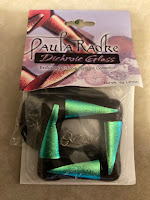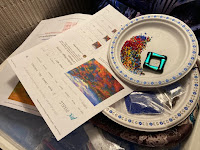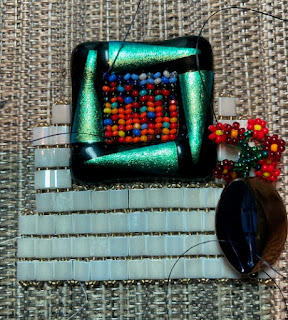Thanks to my Tuesday afternoon Beading Circle for challenging me to create something fresh. Our Zoom meetings are a great opportunity for beady friends to compare notes, share bead trivia, discuss beading technique, spotlight new designers and patterns. Everyone is beading at home with their stashes nearby. It’s fun to do bead along projects.
When the idea of doing a beaded brooch in April arose, folks assumed this would be a bead embroidery challenge. Someone suggested to peruse one’s stash for a button or cabochon as the starting point for a brooch focal. I did not have any buttons.
I’d like to share my creative process of my Still Life Dichroic Brooch.
DICHROIC FRAME ART
I did have a dichroic lampwork square frame pendant kit by
Paula Radke from way back when I was participating in international bead shows
in the late 2000s - early 2010s. I never strung the frame to wear, so it was perfect for my brooch!!
I envisioned the dichroic square as a frame for a miniature artwork. Google is full of images of paintings for inspiration! Rainbow Ridge - Colorful Landscape by Julie Brugh Riffey spoke to me.
I poured a little of every intensely-colored charlotte 11o beads onto a Chinet® plate for painting with beads with the Ndebele technique.
I managed to recreate the feel of Rainbow Ridge one bead at the time. My beaded interpretation is dancing in the frame because of the shadows created by beads sitting at herringbone angles and the charlotte-cut of the beads which reflects light.
STILL LIFE
Next, I used the leftover unique black-copper bead from the TBS 2021 Bag of Bead Challenge for a vase. Using the daisy stitch I filled the vase with beaded red and scarlet flowers.
To make sense, I decided to create a still life composition with my two main elements. Again, I looked through artwork on the internet for ideas. How do I show surfaces, light and shadows using beads? The artwork needs to be hung on the wall. The vase of flowers needs to be placed on a table.
TILA WALL
While scrounging around my stash I found a few surprises. I forgot I bought four tubes of Miyuki Tila Bead. Also, I purchased an assortment of microscopic seed beads from Bead Cats in sizes 16o to 24o. I knew I had bugle beads in different sizes for creating the tabletop.
The flat tile-shaped 2-hole Tila beads were ideal for creating a wall. I played around with square-stitching one tile to another and stringing a wonderful bronze-lined 15o seed bead between stacks of tiles.
The wall grew tall and wide around the frame. The stepped down tile wall reminds me of Art Deco.
I had to work out how to assemble my beadwoven art in the frame, how to stitch my wall down. To create the brooch I needed some foundation to stitch and secure it to. I ordered a stiff felt beading foundation and a faux leather for a backing for my brooch from i-Bead.
NETTED FLORAL TRIM
I wanted my still life tablecloth to have a floral design.
This is where the microscopic seed beads can in handy. The top of the netted tablecloth
has microfine vintage bugles meeting up at the bronze-lined seed bead.
I found these would be a safe bet to connect the netted trim to the foundation. I sketched out a netted design in colored pencils. Clever color placement made it look like flowers with leaves.
Each row of this vertical net is finished in a picot trim. The floral pattern was made to the width of the Tila wall.
Now was the time to stitch down the wall to the foundation. I cut out a rectangle of stiff felt, placed the netted tablecloth and calculated how high should the wall be placed.
How much space to I need for my bugle tabletop between the
two?
BUGLE TABLE
I marked where to stitch the seed bead for the top of my netted tablecloth. This way everything was perfectly spaced.
The wall was stitched down along the seed beads between
Tilas. I then laid out the different colors of bugles trying to capture the
light and depth of a table top.
TIP: To keep the color sequence intact for reference, take clear tape and press down on the bugle layout. The sticky tape will pick up the bugle rows as a single unit. Place it up higher for reference to see which bugle to pick and stitch them permanently in place.
HANGING THE PICTURE FRAME
Then, it was time to hang up the picture. Luckily, there was a space on the wall for the frame. First, I traced the inside of the frame to know the positioning of the herringbone-stitched picture. I stitched my artwork to the foundations by stitching randomly between the beads.
To secure the frame to the foundation, I used a single continuous line of Aileen’s glue. Then I pressed down the dichroic frame in position on top the glue.
Once the glue dried, I stitched down the corners of the frame carefully not to break up the dichroic triangles design. I used single strings of fine black beads to stitch down each corner. Then I reinforced them with extra stitches close to the bead strings. This way the glass frame is securely part of the foundation, an important consideration since I will need to add a brooch pin to wear!Time to add the vase on the tabletop. The tail below the stop bead at the bottom of the copper vase was handy for securing through the tabletop bugle row. I then had to go up through the vase to secure the odd-shaped copper bead. The remaining thread from the daisy flowers was used to stitch down the flowers in a few places.
To balance the composition, I created another vase using an
incised Indian bead as the vase. Petal beads in my stash came in handy to
create an exotic bloom. By stringing a 15o between each petal I was
able to create a flower. It is topped with a melon bead with a coral turnaround
bead for zing. This vase was positioned on the tabletop and stitched down to
the background.
BROOCH PIN
Thanks to Naomi Smith of Black Tulip for sharing her technique of attaching vintage pins to brooches. I borrowed the pin from my Bead Poppy I beaded in her workshop.
TIP: For a discreet brooch clasp, I centered and stitched
across the 1” strip 1/4” down from the top of the faux leather backing. This
was to prevent the vintage brooch pin from riding up too high.
BACKING
The brooch needed a backing for a tidy finish. I used faux leather which was really nice to work with. I cut it out in the same shape as the foundation. Also, I cut out a 1” wide x 3-1/4” brooch pin holder strip.
Time to start stitching the backing onto the foundation. For every stitch I added the 15o seed bead. This created a fine smooth discreet bead edge. The 1” strip was stitched together the backing. When I started stitching up near the black frame, I quickly recalled a tip to darken the edge.
TIP: Use a Permanent Sharpie marker to tone down the white foundation edge.
The bead edge-stitching continued down to the bottom and along the lower edge underneath the netted floral. The lower edge of the brooch pin strip was trimmed even to the lower edge and stitched together with the backing. The bead edge continued up to meet the start.
I slipped in the brooch pin under the strip ready to wear. I’m pleased my brooch is balanced and comfortable to wear.



























No comments:
Post a Comment